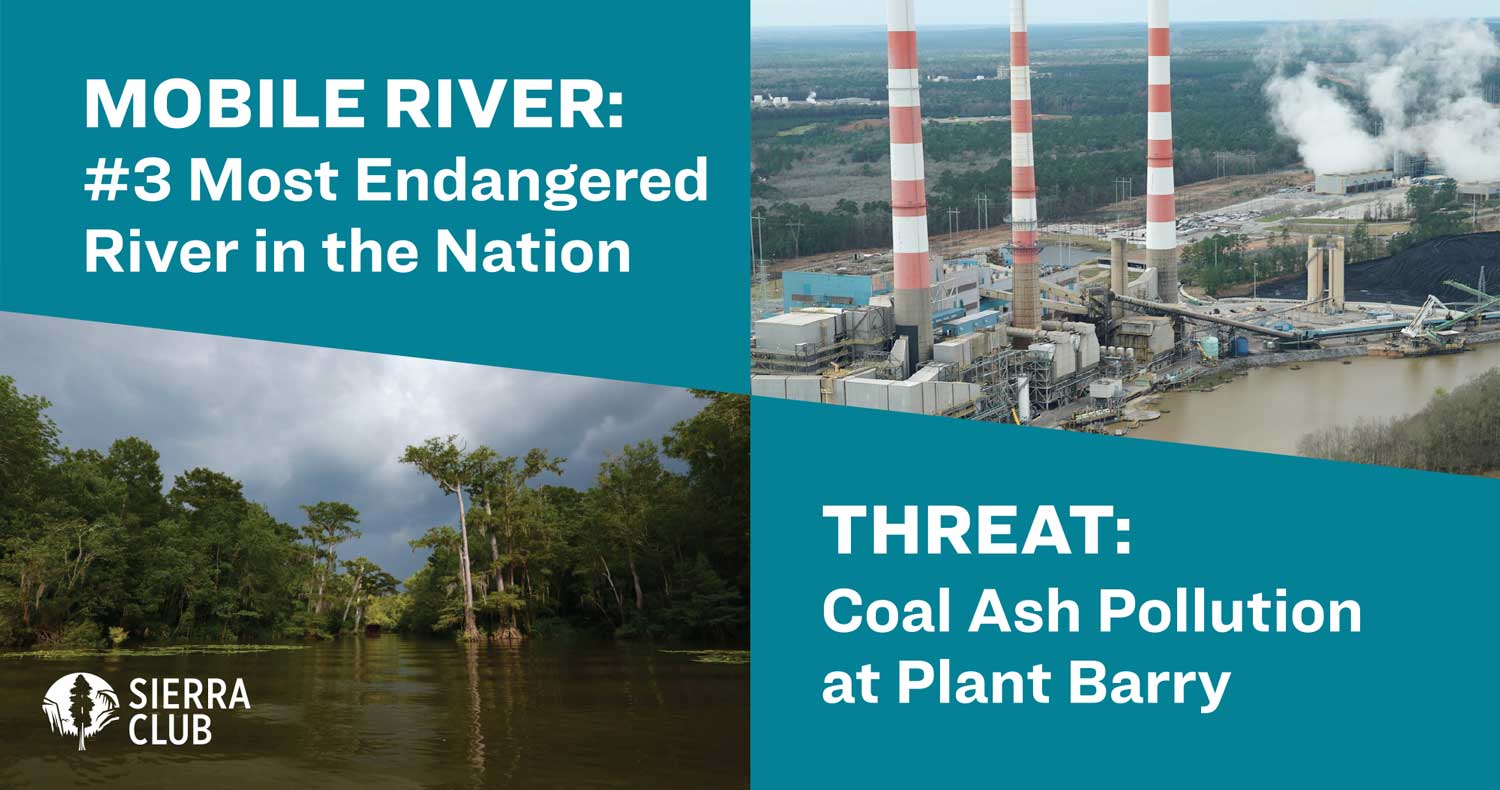
Coal ash pollution threatens clean water, public health
Contact: Ben Emanuel, American Rivers, 706-340-8868
Carol Adams-Davis, Sierra Club, 702-496-5050
Cade Kistler, Mobile Baykeeper, 251-433-4229
Keith Johnston, Southern Environmental Law Center, 205-745-3060
Joe Womack, Africatown-CHESS (Clean, Healthy, Educated, Safe, Sustainable), 251-404-9558
Ramsey Sprague, (MEJAC) Mobile Environmental Justice Action Coalition, 682-556-0553
Charline Whyte, Sierra Club- Beyond Coal, 205-253-4235
Haley Lewis, GASP Group, 205-701-4272[JT1]
Washington, D.C. – American Rivers today named the Mobile River one of America’s Most Endangered Rivers® of 2022, highlighting the threat that coal ash pollution poses to clean water and public health.
The river is threatened by a leaking coal ash pond at Alabama Power’s Plant Barry, which contains more than 21 million tons of toxic coal ash. Water polluted with radium, mercury, arsenic and other cancer-causing chemicals threatens the health of the Mobile-Tensaw Delta, Mobile Bay, the historic African-American community of Africatown, the city of Mobile and the Port of Mobile.
“America’s Most Endangered Rivers is a call to action. Unless we speak up and demand action now, toxic, cancer-causing pollution will threaten communities along the Mobile River for decades to come,” said Ben Emanuel with American Rivers.
American Rivers and its partners called on the Alabama Department of Environmental Management and the U.S. Environmental Protection Agency to enforce the removal and remediation of coal ash from the Plant Barry site and the banks of the Mobile River.
Jonathan Levenshus, Sierra Club Director of Federal Energy Campaigns, released the following statement:
“Coal ash pollution is a serious public health crisis; it poisons the water that communities rely on. Plant Barry’s coal ash ticking time bomb is a demonstrative example of what happens when regulatory agencies like ADEM focus on protecting industry instead of the communities they are supposed to serve.
“Unfortunately, the coal ash at Plant Barry is only one of the sites in the United States that has millions and millions of tons of coal ash that is contaminating waterways. The EPA needs to step in and enforce federal regulations, which clearly state that coal ash cannot be in contact with groundwater. Alabamians deserve protection from pollution, and if ADEM won’t step up to the plate, the EPA must act.”
Coal ash is the concentrated by-product of burning coal and contains contaminants such as radium, mercury, cadmium, arsenic, selenium and other carcinogens. For decades, Alabama Power’s Plant Barry has dumped 21 million tons of toxic coal ash into a 597-acre unlined pit only supported by earthen berms— allowing heavy metals and other toxins to contaminate groundwater and migrate throughout the Mobile River watershed. Plant Barry is surrounded on three sides by the Mobile River and sits in a floodplain of the river next to the Mobile-Tensaw River Delta, a hotspot for diverse plants, fish, birds and wildlife. Federal law now bans coal ash ponds located in these types of locations.
The annual America’s Most Endangered Rivers report is a list of rivers at a crossroads, where key decisions in the coming months will determine the rivers’ fates. Over the years, the report has helped spur many successes including the removal of outdated dams, the protection of rivers with Wild and Scenic designations, and the prevention of harmful development and pollution.
The Rivers of Mobile Bay were previously included on this list in 2017. Also included on this year’s list is the Coosa River, due to the threat of pollution from industrial poultry farms. Other rivers in the region listed as most endangered in recent years include the South River and Turkey Creek (2021), Big Sunflower River (2020 and 2018), Okefenokee Swamp and St. Marys River (2020), and Appalachicola, Chattahoochee, and Flint rivers (2016).
American Rivers reviews nominations for America’s Most Endangered Rivers from local groups and individuals across the country, and selects rivers based on three criteria: 1) the river’s significance to people and wildlife, 2) the magnitude of the threat to the river and communities, especially in light of climate change and environmental justice, 3) a decision in the next 12 months that the public can influence.
America’s Most Endangered Rivers® of 2022
#1 Colorado River
State: CO, UT, AZ, NV, CA, WY, NM, Mexico
Threat: Climate change, outdated water management
#2 Snake River
State: ID, WA, OR
Threat: Four federal dams
#3 Mobile River
State: AL
Threat: Coal ash contamination (Download a pdf that tells the full story of the Mobile River and the threat faced.)
#4 Maine’s Atlantic Salmon Rivers
State: ME
Threat: Dams
#5 Coosa River
State: TN, GA, AL
Threat: Agricultural pollution
#6 Mississippi River
State: MN, WI, IL, IA, MO, KY, TN, AR, MS, LA
Threat: Pollution, habitat loss
#7 Lower Kern River
State: CA
Threat: Excessive water withdrawals
#8 San Pedro River
State: AZ
Threat: Excessive water pumping; loss of Clean Water Act protections
#9 Los Angeles River
State: CA
Threat: Development, pollution
#10 Tar Creek
State: OK
Threat: Pollution
ABOUT AMERICAN RIVERS
American Rivers believes a future of clean water and healthy rivers for everyone, everywhere is essential. Since 1973, we have protected wild rivers, restored damaged rivers and conserved clean water for people and nature. With headquarters in Washington, D.C., and 300,000 supporters, members and volunteers across the country, we are the most trusted and influential river conservation organization in the United States, delivering solutions for a better future. Because life needs rivers. www.AmericanRivers.org
Download a pdf that tells the full story of the Mobile River and the threat faced.